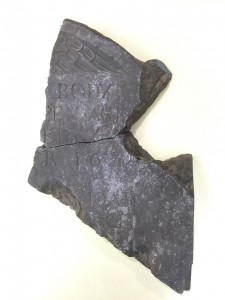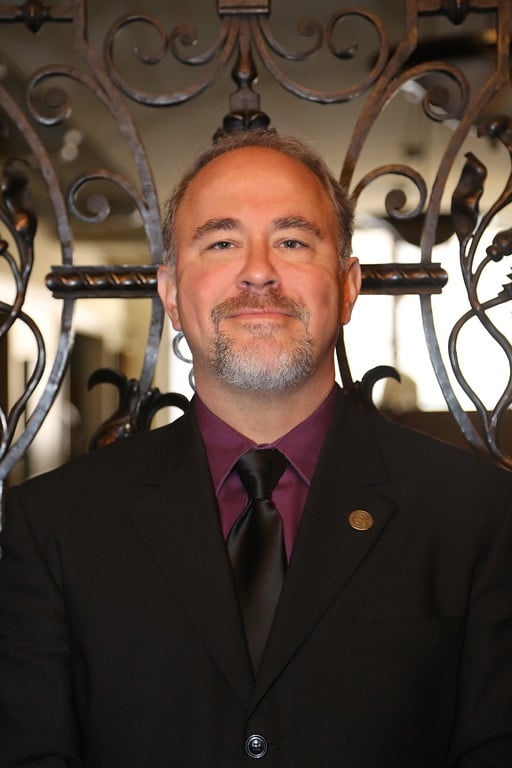 Over the past thirty years I have examined thousands of old slate gravestones in the cemeteries of New England. This fascination led me to write A Guide to Massachusetts Cemeteries, which allowed me to determine the oldest cemeteries in the Commonwealth of Massachusetts.
Over the past thirty years I have examined thousands of old slate gravestones in the cemeteries of New England. This fascination led me to write A Guide to Massachusetts Cemeteries, which allowed me to determine the oldest cemeteries in the Commonwealth of Massachusetts.
When I started at NEHGS in 1993, I came across a curious artifact wrapped in butcher block paper in the Society’s archives. For some time NEHGS had been caretaker of the remaining fragments of the seventeenth-century Bernard/Barnard Capen gravestone. It is uncommon to locate fragments from broken gravestones in local historical societies.
What makes these broken fragments unique is the fact they were reputed to be from the oldest dated gravestone in New England. Upon examination, these wrapped fragments – now stored in an archival box in the R. Stanton Avery Special Collections at NEHGS – offer up another mystery. Barnard Capen (c.1562–1638) married Joan Purchase, daughter of Oliver Purchase, on 31 May 1596. They left Dorset in England and settled in Dorchester, Massachusetts Bay, in 1633. For further details on Barnard Capen, refer to the genealogical sketch by Robert Charles Anderson in The Great Migration Begins: Immigrants to New England 1620-1633, 3 vols., 1: 309–11, or the online sketch on Americanancestors.org.
So does the Capen stone represent the oldest extant gravestone in Massachusetts? Here are two other questions designed to get at an answer:
When did the fragments actually arrive at NEHGS? There is no record of exactly when these broken fragments entered the Society’s collection in Boston. However, a clue I located in The New England Historical and Genealogical Register (October 1895), 49: 489, places its arrival in the early 1890s: “A fragment of the original grave-stone of Barnard and Joan Capen was found a few years ago, in the old cemetery at Dorchester. It is in possession of the New-England Historic Genealogical Society…”
What was the original inscription? All that remains from the original inscription is the following: [Ye] BODY O[F] / [CA]PEN AGE[D] / [DI]ED Ye/ [NOVEMB]ER 163[8] / JOAN / AGED / 26. In the eighteenth century, a replacement stone made out of slate marked the gravesite. Laurel K. Gabel, an authority on early gravestones, informed me the replacement stone is in the style of carver John Dwight, who operated in Dorchester until the 1770s.
It is quite possibly at that point that the fragments were found; perhaps the original stone already lay in pieces, which required the new stone be erected in its place. The current stone at Old North Burying Ground bears the following inscription: HERE / lies the bodies of / Mr. Barnard Capen, / & Mrs. Joan Capen his / wife; He died Nov. 8, / 1638: Aged 76 years,/ & She died March / 26, 1653: / Aged 75 years. This transcription was taken from the image of the stone on Findagrave.com.
This verbatim inscription varies slightly from the inscription published in the Register in 1895, and is not close to the original inscription from the fragments. Based on inscriptions I have seen from the seventeenth century, I would speculate the original inscription went something like this: HERE LYES Ye BODY OF / BARNARD CAPEN AGED / WHO DIED Ye 8th / of NOVEMBER 1638 / AND HIS WIFE JOAN / WHO DIED AGED 75 YEARS / ON 26 / MARCH 1653.
As it stands now, the fragments of the Capen gravestone are not from a gravestone erected in 1638 for Barnard, nor for his wife in 1653. Laurel Gabel and I are in agreement that these fragments are most likely from the 1670s or later, replacing an impermanent wooden marker. An examination of the wings of other seventeenth-century “death heads” used on Dorchester stones may enlighten us as to who created this stone and when it was erected. My search for the oldest surviving gravestone in New England continues.
Share this:

About David Allen Lambert
David Lambert has been on the staff of NEHGS since 1993 and is the organization’s Chief Genealogist. David is an internationally recognized speaker on the topics of genealogy and history. His genealogical expertise includes New England and Atlantic Canadian records of the 17th through 21st century; military records; DNA research; and Native American and African American genealogical research in New England. Lambert has published many articles in the New England Historical and Genealogical Register, the New Hampshire Genealogical Record, Rhode Island Roots, The Mayflower Descendant, and American Ancestors magazine. He has also published A Guide to Massachusetts Cemeteries (NEHGS, 2009). David is an elected Fellow of the Massachusetts Historical Society in Boston, Mass., and a life member of the New Hampshire Society of the Cincinnati. He is also the tribal genealogist for the Massachuset-Punkapoag Indians of Massachusetts.View all posts by David Allen Lambert →